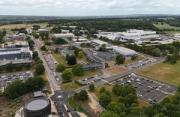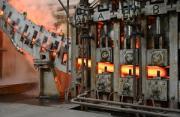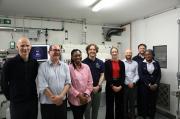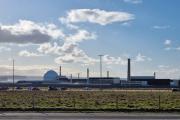Dounreay Reactor Core Drilling Success
7th December 2006
Yet another pioneering invention has successfully allowed the crucial next phase of decommissioning Dounreay's Prototype Fast Reactor (PFR) to begin. The innovative purpose built device, which resembles an extremely long flexible drill, enables pockets of liquid metal to be drained from deep inside the redundant reactor.
The fourteen metre long steel drill, required for accessing isolated areas of the reactor core, was designed in-house by UKAEA's specialist design team, manufactured at JGC Engineering's Harpsdale premises, then rigorously tested by the project team at the T3uk trials and test facility in Janetstown, on the outskirts of Thurso.
Operating successfully on the first attempt, the drill was lowered ten metres to align with a very narrow target area between internal components of the reactor. Then lowered a further four metres to reach the surface to be drilled, the drilling rig had an integral camera to assist with accurate positioning, which provided the first visual inspection of the PFR reactor vessel since operations began in the early 1970's.
Ron Hibbert, who managed the project, said: "This shows how some lateral thinking and good team working can solve technical challenges while decommissioning a complex nuclear reactor that was not initially designed with decommissioning in mind.
He added: "Due to the unique and specialist nature of the work being performed, trials and testing is essential, and without the T3uk facility this could simply not have happened and many projects could not have progressed to where they are today."
Releasing sodium from the reactor vessel allows the remainder of the bulk sodium to be treated within the world-record breaking sodium disposal plant which is due to restart this week. This is the latest in a series of innovative initiatives following a strategic decision to release the maximum amount of trapped sodium before the reactor is dismantled, hence reducing future decommissioning challenges and costs.
Dr Jim McCafferty, who is responsible for the PFR decommissioning project, said: "The success of this project is critical to decommissioning PFR. The removal and destruction of the sodium significantly reduces the hazards associated with decommissioning the plant. Safety is the most important aspect of our work and the project team has maintained an exemplary safety record throughout the drilling project. The expert design and planning by the UKAEA design team, led by Calder Bain, has been crucial to the overall success of the project and is a credit to everyone involved."
PFR operated for twenty years from 1974 until 1994, used 1500 tonnes of liquid sodiummetal to cool the reactor core and transfer the heat through three secondary circuits to a steam-generating plant for electricity production. All the nuclear fuel was removed from the reactor following its closure and the next phase of decommissioning is to dispose of the sodium. PFR had the dual role of providing power to the national grid and offering unique research and development facilities. PFR provided information for the future design and operation of large commercial fast reactor stations and had an electrical output of 250 MW, which was enough electricity to supply a city the size of Aberdeen.
Related Businesses
Related Articles
UKAEA develops 3D printing for fusion components
At its recently opened Central Support Facility (CSF), UKAEA has commissioned an electron beam additive manufacturing machine that can be used to incorporate tungsten into components, alongside a selective laser manufacturing machine. Fusion can play a key role in a global low carbon energy future.Advancing Fusion Remote Maintenance: Industry Collaboration Driving Innovation
As part of the Fusion Futures (FF) programme, UKAEA's Remote Applications in Challenging Environments (RACE) has partnered with industry leaders to develop two groundbreaking technologies for remote maintenance in fusion energy engineering. Thanks to FF funding, industry has taken the lead in maturing UKAEA technology concepts—delivering real-world solutions that enhance operational autonomy and reduce maintenance burdens in extreme environments.UKAEA launches International Fellowships Scheme for fusion
UKAEA has launched the International Fellowships Scheme, an initiative to help expand the global talent pool supporting the fusion industry. The scheme is part of the UKAEA's Fusion Opportunities in Skills, Training, Education and Research (FOSTER) Programme, which aims to train, support, and empower the next generation of professionals, who will help deliver fusion power to the grid.Kyoto Fusioneering and Astral Systems join Culham fusion hub
UKAEA's Culham Campus welcomes Kyoto Fusioneering and Astral Systems as its latest tenants. Two pioneering companies, Kyoto Fusioneering and Astral Systems, have joined the growing cluster of fusion technology and AI organisations at United Kingdom Atomic Energy Authority's (UKAEA) Culham Campus.
Fusion-grade Steel Produced At Scale In UK-first
Researchers achieve 10x production cost savings for reduced activation steel. A United Kingdom Atomic Energy Authority (UKAEA) working group has successfully demonstrated the industrial scale production of fusion-grade steel.
UKAEA To Lead The Creation Of A Robotics And AI Cluster
UKAEA will lead the creation of a new £4.9m nuclear robotics and artificial intelligence cluster across Cumbria and Oxfordshire. The robotics and AI cluster was announced by UK Research and Innovation (UKRI) as one of seven new projects to kickstart economic growth and address regional needs: www.ukri.org The robotics and AI cluster will link Cumbria and Oxfordshire to accelerate the decommissioning of the UK's legacy nuclear fission facilities and keep people out of hazardous environments.
Diamonds Are Forever? World-first Carbon-14 Diamond Battery Made In Uk
The world's first carbon-14 diamond has been produced with the potential to provide power for thousands of years. Scientists and engineers from the UK Atomic Energy Authority (UKAEA) and the University of Bristol have successfully created the world's first carbon-14 diamond battery.
UKAEA Monthly Newsletter Latest Edition
Find out what has been happening at UKAEA in our monthly newsletter. Read about our recent activities and upcoming events.
UKAEA Newsletter - Edition 11 Published Today
Find out what has been happening at UKAEA in our monthly newsletter. Read about our recent activities and upcoming events.
Corwm Visits Dounreay Nuclear Site
Members were given an overview of the scale of the problem and challenges faced in the decommissioning of the site. In the last week of March 2024, several members of CoRWM led by the Chair, Sir Nigel Thrift, made the long journey up to the North of Scotland to visit the Dounreay nuclear site, now managed by Nuclear Restoration Services.
